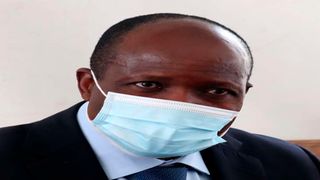
Migori Governor Okoth Obado at the Milimani High Court in Nairobi on July 12, 2021, when his murder trial over the murder of university student Sharon Otieno resumed.
| Dennis Onsongo | Nation Media GroupObado murder trial: Court told how police bungled evidence
Two police officers were yesterday taken to task over the alleged bungling of evidence in the murder trial of Migori Governor Okoth Obado.
The officers were at pains to explain why they used a mobile phone to photograph the murder scene and a paper envelope to carry exhibits found near the body, contrary to the police service standing orders.
Inspector Mary Mogire and Constable Sammy Mendik said the alleged bungling occurred after the Director of Criminal Investigations Officer (DCIO) Rachuonyo South failed to turn up at the scene.
Justice Cecilia Githua heard that the officers also used a tape measure to cordon off the scene as they did not have the standard yellow tape used by the National Police Service.
“After a resident reported at Oyugis Police Station that he had sighted a body at a forest in Rongo, I called the Rachuonyo South DCIO Julius Kasiwai and told him that we had been called to a murder scene,” said Ms Mogire.
“The DCIO said he was away and instructed me to continue with the process of removing the body. I was with Mr Mendik and driver Samuel Maina,” she added.
The process of documenting the scene was not passed over to another DCI officer, with Ms Mogire saying she did not have training on forensics and crime investigations at the time.
She was testifying at the High Court in Milimani in the trial of Mr Obado and two of his aides over the murder of former Rongo University student Sharon Otieno, whose body was found in a forest on September 4, 2018.
Justice Githua heard that photos of the scene were taken by Mr Mendik using his mobile phone. He was also instructed to send them to Mr Kasiwai via WhatsApp. He obliged but later deleted the photos and lost the phone the following year. As a result, the original photographs of the scene were not available to prosecutors.
Sharon’s body was found by Moses Onditi, who was grazing his cattle near Owade River. This was a day after she had been kidnapped in Rongo town.
Ms Mogire said it was a naked body lying on a pool of blood and had stab wounds in the neck and on the lower part of the abdomen.
“It was a rainy season and it appeared there was a struggle. The scene was muddy. There was blood around the neck and the lower abdomen. I formed an opinion that it was murder,” said Ms Mogire. The murder weapon has, however, never been found.
At the scene, the officers said they found various items “randomly thrown” around the body, among them two used and three unused condoms and a sachet of illicit alcohol. They also found Sharon’s blood-stained clothes, a pair of blue open shoes and under pants.
“I collected everything I saw at the scene, recorded them one after another before I packed them in an A3 envelope. I was wearing gloves to ensure no contamination,” said Ms Mogire during cross-examination by defence lawyers Kioko Kilukumi and Kelvin Sagana.
She added that the body was taken to Rachuoyo sub-county hospital mortuary and booked as an unknown female. Her evidence was, however, contradicted by Mr Mendik, who said the items were put in an A5 envelope.
Asked by the defence lawyers why the officers acted contrary to the standing orders, which require the exhibits to be stored in a plastic bag, the witness said they did not have such a bag.
He added that they borrowed eight pairs of gloves from Rachuonyo Hospital. The officers also confirmed to court that the exhibit could have been used in locating the killers, specifically and with precision through scientific forensic investigation.
Mr Mendik added that they visited the scene of murder two days later, on September 7, with a team of homicide detectives from the DCI headquarters in Nairobi.
The items were handed over to the detectives, who reconstructed the scene, photographed it using their gadgets and took over the investigations that led to the arrest of Mr Obado, his personal assistant Michael Oyamo and county government clerk Casper Obiero.
Hearing continues.





